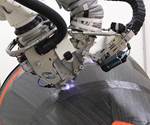OOA: Thermoplastic alternative targets performance spec
CF/PEEK helicopter driveshaft’s toughness trumps traditional metric.
Share
A strong advocate of thermoplastic composites, David Hauber, VP of Engineering at Automated Dynamics (Schenectady, NY, US), is working diligently to dispel what he calls the “myth” of the necessity for <1% porosity (void content) in composite aerostructures. “The key is not porosity,” he contends. “It’s performance. Tough thermoplastic materials are much less sensitive to porosity than their more brittle thermoset counterparts.”
For proof of this, Hauber points to work Automated Dynamics has done developing a thermoplastic driveshaft for helicopter use that offers a 35% weight reduction compared to its aluminum predecessor, with 150% post-ballistic torque to failure — all with 4% porosity. The project was funded by a Navy Small Business Innovation Research (SBIR) Phase II grant that partnered ADC with SURVICE Engineering (Belcamp, MD, US) and UTC Aerospace Systems (UTAS, Rome, NY, US).
The driveshaft is composed of a carbon fiber/polyetheretherketone (PEEK) prepreg that features HexTow IM7 fiber, from Hexcel (Stamford, CT, US). The prepreg is in-situ placed via an automated fiber placement (AFP) system developed by Automated Dynamics, on a cylindrical aluminum mandrel. The system’s short heat-affected zone and high pressure applied at laydown produces a shaft that is immediately and fully consolidated, with, says Hauber, no post-process work required to finish cure.
After consolidation, the shaft is removed from the mandrel, trimmed and sent to UTC Aerospace Systems, where end-fittings are added and testing begins.
The shaft’s key performance metric is how it responds in a ballistic environment, and this, says Hauber, is what led the customer to thermoplastics in the first place. “The initial impetus for going to thermoplastics for this shaft was for better operational durability,” he points out.
To assess the ballistic response, SURVICE simulates what Hauber says is considered the worst possible damage a shaft might endure: a glancing blow from a high-speed projectile. The shaft is then tested to failure in a damaged state; the Automated Dynamics shaft, reports Hauber, failed at 150% of the required value. Feedback has been very positive; the next step will be testing the shaft in an operational environment, with a goal of TRL 6.
Hauber acknowledges that thermoplastic composites advocates have a long row to hoe convincing the aerospace industry that product performance trumps porosity values. This is particularly challenging given the long qualification cycles a material must endure before it is approved for commercial use: “It’s very expensive to characterize and qualify a new material,” he says. “The challenge is to overcome the perceived risk by demonstrating improved performance in a demanding operating environment.”
Related Content
-
CFRTP upper stage propellant tank
PROCOMP uses in-situ consolidation AFP and ultrasonic welding to demonstrate lightweight, novel tank design.
-
PEEK vs. PEKK vs. PAEK and continuous compression molding
Suppliers of thermoplastics and carbon fiber chime in regarding PEEK vs. PEKK, and now PAEK, as well as in-situ consolidation — the supply chain for thermoplastic tape composites continues to evolve.
-
The potential for thermoplastic composite nacelles
Collins Aerospace draws on global team, decades of experience to demonstrate large, curved AFP and welded structures for the next generation of aircraft.














